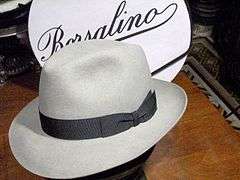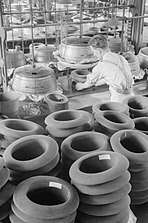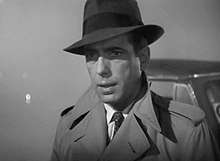Fedora
A fedora /fɪˈdɔːrə/[1] is a hat with a soft brim and indented crown.[1][2] It is typically creased lengthwise down the crown and "pinched" near the front on both sides.[3] Fedoras can also be creased with teardrop crowns, diamond crowns, center dents, and others, and the positioning of pinches can vary. The typical crown height is 4.5 inches (11 cm). The term fedora was in use as early as 1891. Its popularity soared, and eventually it eclipsed the similar-looking homburg.[2]


The fedora hat's brim is usually wide, approximately 2.5 inches (6.4 cm) wide, but may be wider,[2] can be left raw-edged (left as cut), finished with a sewn overwelt or underwelt, or bound with a trim-ribbon. Stitched edge means that there is one, two, or more rows of stitching radiating inward toward the crown. The Cavanagh edge is a welted edge with invisible stitching to hold it in place and is a very expensive treatment that can no longer be performed by modern hat factories.[4] Fedora hats are not to be confused with small brimmed hats called trilbies.[2][5]
Fedoras can be made of wool, cashmere, rabbit or beaver felt. These felts can also be blended to each other with mink or chinchilla[4][6] and rarely with vicuña, guanaco, cervelt,[7] or mohair. They can also be made of straw, cotton, waxed or oiled cotton, hemp, linen or leather.
A special variation is the rollable, foldaway or crushable fedora (rollable and crushable are not the same) with a certain or open crown (open-crown fedoras can be bashed and shaped in many variations). Special fedoras have a ventilated crown with grommets, mesh inlets or penetrations for a better air circulation. Fedoras can be lined or unlined and have a leather[8] or cloth[9] or ribbon sweatband. Small feathers are sometimes added as decoration. Fedoras can be equipped with a chinstrap, but this is rare.
History
The term fedora was in use as early as 1891. Its popularity soared, and eventually it eclipsed the similar-looking homburg.[2] The word fedora comes from the title of an 1882 play by dramatist Victorien Sardou, Fédora, which was written for Sarah Bernhardt.[10] The play was first performed in the United States in 1889. Bernhardt played Princess Fédora Romanov, the heroine of the play. During the play, Bernhardt – a noted cross-dresser – wore a center-creased, soft brimmed hat. The hat was fashionable for women, and the women's rights movement adopted it as a symbol.[11][12] After Edward, Prince of Wales started wearing them in 1924, it became popular among men for its stylishness and its ability to protect the wearer's head from the wind and weather.[11][12] Since the early part of the 20th century, many Haredi and other Orthodox Jews have made black fedoras normal to their daily wear.[13]
Fedoras in early American society

During the early twentieth century, a hat was a staple of men's fashion and would be worn in almost all public places. However, as a social custom and common courtesy, men would remove their hats when at home or when engaged in conversation with women.[14] In addition, the ability to own a hat was culturally considered a sign of wealth due to fashion being recognized as a “status symbol.” Only those with few economic resources would venture the streets without a hat.[15] The introduction of a new line of felt hats made from nutria, which is an animal similar to the beaver, helped establish the fedora as a durable product. Prices, in the first decade of the twentieth century, for a nutria fedora ranged from ninety-eight cents to two dollars and twenty-five cents.[15] Starting in the 1920s, fedoras began to rise in popularity after the Prince of Wales adopted the felt hat as his favored headwear. As a result, “the soft felt hat replaced the stiff hat as the best seller in the decade.” The fedora soon took its place as a choice hat and joined other popular styles that included the derby, homburg, and Panama.[15]
In America during the 1940s, the brims of fedoras started to increase in width, while the British maintained a slightly smaller brim size. The colors of fedoras traditionally included shades of black, brown, and gray. However, this palette would grow at the onset of the second world war to include military themed colors such as khaki, blue, and green. One of the most prominent companies to sell fedoras was the department store Sears, Roebuck and Company. In addition, famous hat manufacturers which still exist today include Bailey, Borsalino, and Stetson.[15]
Women and fedoras
In the 1880s, French stage actress Sarah Bernhardt popularized the fedora for the female audience. It soon became a common fashion accessory for many women, especially among activists fighting for gender equality during the late nineteenth century.[16] The fedora was eventually adopted as a defining symbol of the women's rights movement. It would not be until 1924 when, in Britain, the fashion minded Prince Edward started wearing the felt hat. This event shifted the popularity of the fedora over to men's fashion, making the hat one of the few androgynous clothing pieces.[17]
To this day, fedoras continue to be worn by women, however, not quite to the same extent as they once were in the early twentieth century. Women's fedoras vary in form, texture, and color. In addition, these fedoras come in almost every color from basic black to bright red and even in the occasional animal print.[18] Along with men's felt hats, women's fedoras are making a comeback in current fashion trends. Baseball caps, which have in recent years been the staple of headwear, are currently experiencing a decline in popularity amidst this “fedora renaissance.”[19]
Make and form

Fedoras are usually made by pressing a piece of felt over a mold, and using some kind of heat or sealant to help the felt keep its shape. In the past, molds were created by using a series of wooden blocks to create the shape of the hat, and the felt was pressed on with an iron.[20] The current method is to use metal molds and machinery to create enough pressure to form the shape of the hat.[21] After the general shape of the hat has been achieved, the hat makers attach some sort of decoration, usually a ribbon, between the brim and the crown of the hat. The brim is either left raw, or hemmed.[20] The fedora is considered a “soft hat,” which means that it is usually constructed from felt, fur, or animal hides.[22] There are variations from hat to hat, but the standard design includes a creased crown, angled brim, a pinch at the top of the hat, and some sort of decoration above the brim of the hat.[23] Men's fedoras especially tend to have stylized brims with edges that are turned down in the front and up in the back. As mentioned earlier, the width of the brim, overall size and color of the hats are subject to change with fashion trends. Women's hats also tend to have more elaborate decorations and slimmer designs.[22]
Because of the soft nature of the hat, many variations are possible with Fedoras. One variation of the hat includes the Stetson playboy hat which was popular in the 1940s. The Stetson playboy hat involved a marketing success story, with a simple variation on the general form of the fedora becoming a huge hat trend in America. Al Capone was very fond of the playboy style. Many famous pictures of Capone depict him sporting a Stetson playboy hat.[23]
Contemporary takes on the fedora include asymmetrical brims, bright colors, eccentric patterns, and flashy decorations.[18] Some fedoras are now made from straw, and other unconventional materials. However, despite the increase of artistic hats, the most commonly worn fedoras are still neutral colored, with simple shape and design.[23]
In popular culture
Fedoras became widely associated with gangsters and Prohibition, a connection coinciding with the height of the hat's popularity between the 1920s and the early 1950s.[11][12] In the second half of the 1950s, the fedora fell out of favor in a shift towards more informal clothing styles.[11][12]
Coach Tom Landry also wore the hat while he was the head coach of the Dallas Cowboys. It would later become his trademark image. A cenotaph dedicated to Landry with a depiction of his fedora was placed in the official Texas State Cemetery in Austin at the family's request.[24] In addition the Cowboys wore a patch on their uniforms during the 2000 season depicting Landry's fedora.[25]
Comedian and entertainer Jimmy Durante wore a fedora as a standard part of his stage clothing throughout his career.
Bear Bryant, long-time coach at the University of Alabama was known for wearing a black-and-white houndstooth fedora.
Indiana Jones re-popularized the fedora in the Indiana Jones franchise.[26] The backstory of how he obtains the hat is told in the prologue of Indiana Jones and the Last Crusade, the third film of the series, and the character who gives him the hat is credited as "Fedora". The character Freddy Krueger, from the Nightmare on Elm Street franchise, also wears a brown fedora.[27][28]
This hat is also worn by the fictional female international thief Carmen Sandiego. It is mostly seen being the color red along with the rest of her trench coat.
The fedora hat of the ninth president of Turkey, Süleyman Demirel, was a famous part of the president's image.[29][30]
In the 21st century, the fedora has made a reappearance in the fashion world along with other types of classic hats such as the porkpie and the homburg. According to H. Lee Murphy, fedoras are a bold new fashion statement, but still maintain a certain amount of nostalgia. Murphy credits celebrities such as Johnny Depp, Brad Pitt, and Justin Timberlake for the new wave of fedoras.[31] In addition, the fedora has appeared in recent portrayals of movies and television shows, set in the past, such as Mad Men (2007–15), Shutter Island (2010), and Boardwalk Empire (2010–14). Michael Jackson also frequently wore a fedora while performing on stage.[32]
By the early 21st century, the fedora had become a symbol of hipsters.[33] Vice has referred to the early 2000s as a "fedora renaissance", with celebrities like Johnny Depp and Pete Doherty wearing the hat, but claimed that by 2016, the fedora may be "the single most-hated fashion accessory money can buy".[34] This is caused by the association of the fedora (or the trilby, which is often confused with it) with the "neckbeard" stereotype.[34] During this latter period, James Toback was noted for his love of fedoras.[35]
In film noir

The fedora has become a defining characteristic of film noir when examined from a fashion standpoint. Film noir, which is often defined by its innovative camera techniques, gritty stories, and femme fatales, has also come to include fashion as a part of the genre.[14] The fedora has been the chosen accessory of movie detectives and criminals alike. One of the most notable actors to wear a wide-brimmed fedora hat was Humphrey Bogart in his portrayal of Sam Spade in “The Maltese Falcon.” In this film, the character Sam Spade owns and wears several fedoras. Ula Lukszo states that audiences can gain insight into “main characters via their clothing”. Therefore, modern films have a tendency to focus on fedoras in order to create a connection to this specific genre. Further, it has gained an association with Hollywood's image of the 1940s and is a prominent clothing accessory in modern films set within this historical time period.[14]
Billy Wilder wrote and directed the 1978 film Fedora, which takes its title from the female lead character played by Marthe Keller. In addition, fedoras are a strong theme throughout the picture. The title also pays homage to the iconic accessory commonly worn in Noir films from the 1940s and '50s.[36] Billy Wilder also participated in directing films such as “Sunset Boulevard” and “Some Like it Hot” in the era of Hollywood's golden age. As a result, most of Wilder's work features fedoras prominently in promotional materials as well as in the finished films.[37]
Gangsters and jazz
Fedoras were an important accessory to the zoot suit ensemble which emerged onto the American fashion scene during the 1940s. Zoot suits were mainly associated with Mexican and African Americans and were largely worn in segregated minority communities. As a result, this style soon spread to local jazz musicians who adopted this look and brought it to their audiences. In addition, well-known gangsters such as Al Capone, Charles Luciano, and Benjamin "Bugsy" Siegel used the fedora to create a "tough guy" image. The association of the fedora with the zoot suit and gangster culture has caused the general public to view it according to this limited connotation.[38]
In Orthodox Judaism
In Orthodox Judaism, fedoras have been an important addition to a man's wardrobe. Lithuanian yeshiva students in the first half of 20th century wore light hats (as was popular in much of the Western world) during prayer and sometimes even while studying, as evident in a rare footage of the Ponevezh Yeshiva and a photo of the Lomza Yeshiva both in Eastern Europe. Both the footage and the photo show students' studying in their hats. Hasidic Jews wore black hats, albeit not fedoras, and in the later half of the 20th century, non-Hasidic (Lithuanian style) yeshiva students began to wear black fedoras (or dark blue or gray). Today, many yeshiva students and Orthodox men wear black fedoras for prayer and many even while walking outside. In recent years, Sefardic Jews began to wear black fedoras too.
See also
References
- "fedora". Oxford Dictionaries UK Dictionary. Oxford University Press. Retrieved January 9, 2017.
- Kilgour, Ruth Edwards (1958). A Pageant of Hats Ancient and Modern. R. M. McBride Company.
- Cotton, Elizabeth (1999). Hats. Stewart, Tabori & Chang.
- Hat Glossary Retrieved 03.14.2016.
- When a Fedora That Isn't a Fedora Is a Fedora Retrieved 03-09-2017.
- Super felt Archived 2016-06-16 at the Wayback Machine Retrieved 2016-03-16.
- Cervelt Retrieved 2016-03-14.
- "Observations on Fedora Sweatbands, Size Tags, and Fedora Dating Tips". Publius Forum.
- Sweatbands Retrieved 2016-03-15.
- Encarta Dictionary, Microsoft Encarta Premium Suite 2004.
- "History of Fedora Hats". History of Hats. Retrieved June 24, 2014.
- Rath, Robert (March 6, 2014). "The History And Abuse of The Fedora". The Escapist. Retrieved June 24, 2014.
- Shields, Jody; Dugdale, John (1991). Hats: A Stylish History and Collector's Guide. Clarkson Potter.
- Schoeffler, O. E. (1973). Esquire's Encyclopedia of 20th Century Men's Fashions. McGraw-Hill. pp. 323–342.
- Amies, Hardy (2007). ABC of Men's Fashion. V&A Publications. pp. 21, 44, 57–58.
- "History of Fedora - Who Invented the Fedora Hat?". www.historyofhats.net. Retrieved April 6, 2019.
- "The History of the Fedora". Bernard Hats. Retrieved April 6, 2019.
- Nestoras, Bessie (2013). "Fall for Autumn". Gifts & Decorative Accessories: 120–130 – via BYU Library.
- Briere, Rachel R. (2007). "Crowning Glories: The Fedora is Making a Comeback Against the Baseball Cap". Sun, The (Lowell, MA) – via Ebscohost.
- Updike, Robin (2017). "A Hat for all Seasons Wayne Wichern". Ornament: 48–53.
- Cohen, Edie. "Heads Above the Rest". Interior Design: 192–199.
- Lukszo, Ula (2011). Noir Fashion and Noir as Fashion. Indiana: Indiana University Press. pp. 54–81.
- "Fedora Felt Hat Guide — Gentleman's Gazette". www.gentlemansgazette.com. Retrieved March 17, 2019.
- "Thomas Wade Landry". Texas State Cemetery. Retrieved March 4, 2013.
- "ESPN DALLAS Hall of Fame - Tom Landry no longer top of mind". ESPN. January 2, 2010. Retrieved September 23, 2012.
- Hellqvist, David (September 4, 2014). "The Hats: Heads Up". Port Magazine. Retrieved October 10, 2013. Harrison Ford sported a Herbert Johnson felt fedora as Indiana Jones in Raiders of the Lost Ark.
- Reed Tucker (October 29, 2016). "How a strange man in a fedora inspired Wes Craven's Freddy Krueger". The New York Post. Retrieved April 30, 2019.
- John Squires (April 24, 2019). "Freddy Krueger Kicks Off Cryptozoic's New "Vinyl Terrorz" Toy Line". Bloody Disgusting. Retrieved April 30, 2019.
- Anadolu Agency. "Turkey's 9th President Suleyman Demirel dies at 91". Getty Images.
- "HATS: A POLITICAL SYMBOL OF TURKISH HISTORY". Retrieved November 27, 2017.
- Murphy, H. Lee (2011). "Trilby or Trendy, Fashion-Conscions Men Mad About Hats". Crain's Chicago Business. 34: 23 – via Nexis Uni.
- Millar, Jamie. "The best fedoras from film and TV history". British GQ. Retrieved April 6, 2019.
- Rutenberg, Jim (August 5, 2012). "Montauk's Hipster Fatigue". The New York Times. pp. ST1. Retrieved November 19, 2015.
- "I Wore a Fedora for a Week to See if It Would Ruin My Life". November 22, 2016. Retrieved March 11, 2018.
- "38 Women Accuse Director James Toback Of Sexual Harassment: 'I Felt Like A Prostitute'". October 23, 2017. Retrieved March 11, 2018.
- Fedora, retrieved April 6, 2019
- Phillips, Gene D. (2010). Some Like it Wilder. Kentucky: The University Press of Kentucky.
- McClendon, Alphonso D. (2015). A Stylish History of Jazz. London: Bloomsbury Academic. pp. 15–42.